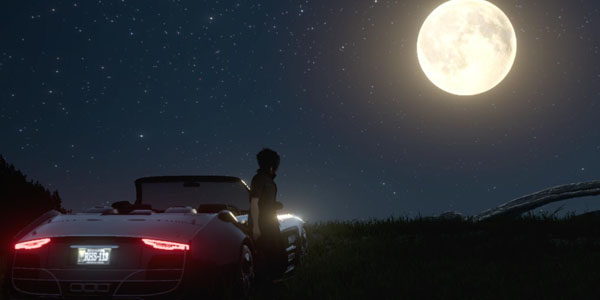
Final Fantasy XV è stato oggetto di tantissime informazioni svelate da un ex-dipendete di Square Enix, ovvero Julien Merceron, che era addetto allo sviluppo del Luminous Engine, ovvero il motore grafico che muove questo nuovo capitolo della serie che dovrebbe essere disponibile il prossimo anno su PlayStation 4 e Xbox One.
Grazie ai ragazzi di DualShockers siamo entrati in possesso di queste informazioni che abbiamo riportato di seguito:
During a lecture held at the Cité des Sciences et de l’Industrie in Paris, attended by DualShockers, Former Square Enix Technology Director Julien Merceron gave his insight on the transition between Final Fantasy Versus XIII and Final Fantasy XV.
While Final Fantasy XV was still named Versus XIII, Merceron was wrking on XIII-2, and the concept of Versus XIIIwas constantly evolving. The technology the development team used at that time gradually became less and less in line with the project, as the concept was changing so much. The game became open world, a new tech had to be created for the field, streaming and other features had to be added and caused a lot of problems for the team.
At the same time, Final Fantasy XIV was causing problems as well, and this was a wake up call for Square Enix and something had to be done about it. The publisher recruited a developer from Sega, whom brought some other members of his former team. The newcomers had an enormous experience in physically-based lighting, but that time Merceron still wasn’t 100% sure about taking that direction, because he was very conscious of the hardware limitations of the PS3 and Xbox 360, and of the problems encountered with the same technology at Eidos.
That said, the new team members had a huge experience in the field, and at the same the game’s concept had less characters than what they had at Eidos, Environments were a little smoother, and pushing equations a little bit in less comfortable areas, started to look less scary for Merceron.
The team discussed the problem and found a solution, similar to the approach used by Ubisoft, creating an approximate system that allowed real-time rendering during editing. They started working on the graphics and on the animations. Their first objective was to create a cinematics editor, creating visuals, animations, special effects and particles. They also implemented a system allowing to manage events, triggering different kind of events during cinematics, transitioning from one scene to the other, and so on. That was the first thing they fixed, leading to the evolution of the game.
Asked whether Final Fantasy XV will live up to its ambitions now that direction is in the hands of Hajime Tabata, Merceron answered that he doesn’t know many developers in the west or in Japan that are fully satisfied with the results of their work. When they finish a project, there’s always a feeling that it is incomplete, that more could be added here and there. They always have a desire to go back and rework something, which is now possible with patches (that developers unfortunately abuse a lot according to Merceron). That’s why he thinks that the team won’t be fully satisfied when the game will release, but this is what will give birth to an awesome Final Fantasy XVI.
During a masterclass lecture held at the Cité des Sciences et de l’Industrie in Paris, that DualShockers attended, former Square Enix Worldwide Technology Director Julien Merceron explained why Square Enix shifted from using Luminous Engine on several games to only Final Fantasy XV.
Merceron explained that it’s difficult to share an engine without first creating a game on it. Some companies do that, but he wouldn’t. When he creates an engine, a game also has to be developed with that engine. After the engine proves itself in said game, then the technology can be shared, as the developers can finally say that it works.
If the engine hasn’t proved its worth, there’s a constant risk of problems. In fact, with the Fox Engine, the team did not start working on Pro Evolution Soccer before finishing Metal Gear Solid V: Ground Zeroes. The decision to use Fox Engine in PES was taken after Ground Zeroes was completed, and the team was sure that the engine could deliver.
The same goes for Luminous. Merceron recommended to Square Enix to release Final Fantasy XV and then see what happened with it, before using Luminous Engine with other games.
While Merceron did not mention it, it’s possible that Square Enix expected Final Fantasy XV to be released earlier, so that the engine could be used on Kingdom Hearts III and more afterwards. Then when development of the latest Final Fantasy started taking more time than anticipated they may have decided to switch to Unreal Engine 4. Of course this is just my speculation, so take it with the customary grain of salt.
During a lecture held at the Cité des Sciences et de l’Industrie in Paris, attended by DualShockers, Former Square Enix Worldwide Technology Director Julien Merceron talked about the spectacular tech demo Agni’s Philosophy, that debuted in 2013.
Asked how it’s possible for the demo to be translated from an advanced PC to a much less powerful PS4 hardware without losing graphical fidelity, Merceron joked by saying the answer should not be revealed outside of the audience, and mentioned that with Agni’s Philosophy his team created the cinematic tools and the engine, while the assets (textures, models and so forth) were created by the artists of the studio that worked on theFinal Fantasy animated movie Spirits Within.
According to Merceron, that studio had no experience in real time rendering, and above all they create assets for movies, and those assets were absolutely not optimized. The density of polygons and useless elements was horrifying, and there was no notion of object culling (a technique that renders only what is visible). If you look at it in Maya, the whole thing is a big mesh with no instances.
Thanks to that, Merceron’s team found a number of ways to optimize the assets without changing the quality of the visuals at short distances.
It wasn’t all the artists’ fault, as there were many engine optimizations that were also done, as the demo that was shown at E3 was actually finished just the day before.
The particle engine was completely redone for The PS4, the shaders were adapted to the console, and streaming was reworked. On PC a small trick was implemented for it to look like a single cinematic scene, but on PS4 that choice was not available. Other small optimizations were also done on the memory management side for it to run smoothly.
This, according to Merceron, demonstrates once more that optimization can be done on everything. In the end the team did not have to sacrifice the quality of the assets close to the camera. In fact, the artists never noticed a difference, despite the fact that the parts that didn’t appear on camera were gutted.
That said, the biggest part of the quality you see when you look at Agni’s Philosophy is due to the artists’ work, and it’s absolutely amazing. Merceron was surprised by what they were able to create, and it pushed the team forward. Hair and similar elements had to be created procedurally, lighting and shading had to work correctly, so his had to push hard on the technology side to live up to the work of the artists.

